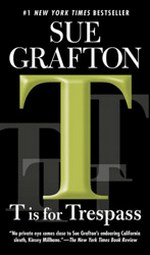this is rushed, I’m having Internet shortages this week (long story, don’t ask), so I want to get this posted while I can. I may end up polishing it up within the day, if there are problems/typos/incomplete sentences, etc. — leave a comment
—
by Sue Grafton
Series: Kinsey Millhone, #24
Hardcover, 403 pg.
Marian Wood Books/Putnam, 2015
Read: October 28 – 30, 2015

I’d forgotten how slow these books start, if I didn’t have confidence in Grafton built over 23 previous novels, I don’t know if I’d have kept going. By page 100, I was curious about both mysteries, engaged enough to keep going – but still no serial killer, no interesting crime — a lot of X’s in character names and whatnot — enough that you know Grafton intended them. The highlight had been meeting Cheney Phillips’ mom, fer crying out loud! You’d think with just three books in the series remaining, Grafton would be pulling out all stops to make this dazzle the readers, but nope. This book is possibly the most subtle, where the actual mystery, the heart of the book is lost in the midst of the mundane — not unlike actual life. Really, most of this book was the Adventures of Kinsey Millhone, Busybody with Too Much Time on Her Hands.
By this point, if we know nothing else, we’ve learned that you do not move into Kinsey and Henry’s neighborhood. If Kinsey decides she doesn’t like you, your life is going to be pried into, turned upside down, and — ultimately — you’ll find yourself living somewhere else. Gladys Kravitz has nothing on Kinsey. Now, whether it’s a gold-digger sniffing around Henry, an insane nurse, or what have you, Kinsey’s gut has been right — but she can’t bat a thousand, can she? Still, Henry gets some new neighbors who get him to run all over town on their behalf while he obsesses with a potential drought and water rationing — and by obsesses, I mean he turns in to Adrian Monk. Kinsey sees them taking advantage of Henry and steps in. I really didn’t like this storyline — Kinsey came off as a shrew (and, yes, I get it — part of this series has always been showing her warts and all — still, I want to expect more from her), no matter how rude and manipulative and possibly worse these new neighbors may be.
There’s another storyline that’s kicked off in the Prologue — I noted after reading it that we wouldn’t return to that for 300 pages or so. I was off by about 100, a mistake I’m willing to make. But it didn’t come back in the way I expected. Kinsey is hired for a job, and after completing it, she’s visited by the police, and she learns that she wasn’t working for who she thought she was — and that’s just the beginning of the problems — so she starts digging into her client, and what that client wanted her to accomplish anyway. This is one of the strangest, and possibly the most pointless, mystery Kinsey’s reported to us. With an oddly sentimental ending.
Pete Wolinsky, investigator of dubious morality from W is for Wasted (and Kinsey’s early days as a P. I.) turns up again. His widow, Ruthie, is facing an IRS audit and asks Kinsey to look through the papers she still has of his laying around for any financial records. Kinsey gets around to it eventually, and in the process finds some well-hidden materials and a coded message. Henry, puzzle-writer extraordinaire, decodes it and comes up with a list of names — some of which have a connection to one of Pete’s cases that Kinsey was aware of, but the rest are a mystery. This starts needling at Kinsey’s curiosity (which is already purring along thanks to the mysterious client above), and she starts going over Pete’s tracks, trying to see what was so important that he would feel compelled to leave notes in a code. Not only does this involve going back over Pete’s case, but decades before — and then back to the present. The rocks she turns over reveal a good deal, and maybe even help Kinsey learn to appreciate Pete in a way she should’ve while he was still with us.
We do check in with Jonah Robb, Robert Dietz, and the aforementioned Cheney Phillips, but nothing happens at all even approaching romance. Which is fine by me, Kinsey on her own is more interesting than Kinsey trying to make things work with a guy. Naturally, we spend a little time at Rosie’s and see William make a bold fashion choice. Yeah, it’s just that exciting a book.
There’s a character early on that the reader (and Kinsey) pegs as the major villain of the piece, but he’s never focused on to the exclusion of all the other moving pieces, so that when things get serious and dangerous, it’s almost as much of a surprise to the reader as it is to Kinsey. I think the way Grafton pulls off handling the storyline, letting the danger get hidden in the shuffle is what made me rank it so high. Actually, as I write this I’m wanting to rank it lower, but I’m going to trust my initial judgment on this (but honestly, I’ve read a couple of 2 star reviews for this that I wholeheartedly agree with). It was nice going back to Santa Teresa to spend time with the old gang, but I’m really hoping Grafton makes these next two a little more worth the effort.
—–

 P is for Peril by Sue Grafton
P is for Peril by Sue Grafton![]()














